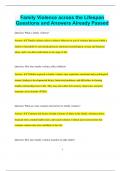Family Violence across the Lifespan
Questions and Answers Already Passed
Question: What is family violence?
Answer: ✔✔ Family violence refers to abusive behavior or acts of violence that occur within a
family or household. It can include physical, emotional, psychological, sexual, and financial
abuse, and it can affect individuals at any stage of life.
Question: How does family violence affect children?
Answer: ✔✔ Children exposed to family violence may experience emotional and psychological
trauma, leading to developmental delays, behavioral problems, and difficulties in forming
healthy relationships later in life. They may also suffer from anxiety, depression, and post-
traumatic stress disorder (PTSD).
Question: What are some common risk factors for family violence?
Answer: ✔✔ Common risk factors include a history of abuse in the family, substance abuse,
financial stress, mental health issues, and social isolation. Cultural and societal norms that
condone violence may also contribute to the risk.
Question: How does family violence manifest in older adults?
1
,Answer: ✔✔ Family violence in older adults, often referred to as elder abuse, can include
physical, emotional, and financial abuse, as well as neglect. It often occurs when an elderly
person is dependent on family members for care, making them vulnerable to mistreatment.
Question: What are the long-term effects of family violence on survivors?
Answer: ✔✔ Long-term effects can include chronic physical health problems, mental health
issues like anxiety and depression, difficulties in forming and maintaining relationships, and an
increased risk of substance abuse. Survivors may also experience ongoing trauma and have
difficulty trusting others.
Question: What role does economic stress play in family violence?
Answer: ✔✔ Economic stress can exacerbate tensions within a household, leading to an
increased likelihood of family violence. Financial insecurity can create power imbalances,
increase stress, and limit the options for victims to escape abusive situations.
Question: How does family violence differ across the lifespan?
Answer: ✔✔ Family violence can affect individuals differently depending on their age. Children
and adolescents may experience abuse from parents or siblings, adults may experience intimate
partner violence, and older adults may face abuse from their children or caregivers. The type and
impact of violence can vary at each life stage.
2
,Question: What is the cycle of violence in family settings?
Answer: ✔✔ The cycle of violence typically involves a recurring pattern of tension-building, an
abusive incident, and a honeymoon phase where the abuser may apologize and promise change.
This cycle can repeat and escalate over time.
Question: How can society prevent family violence?
Answer: ✔✔ Prevention strategies include promoting awareness and education about the signs of
family violence, offering support services for victims, implementing legal protections, and
fostering healthy family dynamics through counseling and community programs.
Question: What are some challenges in addressing family violence?
Answer: ✔✔ Challenges include the stigma associated with reporting abuse, fear of retaliation,
financial dependency on the abuser, lack of access to support services, and cultural or societal
norms that may discourage victims from seeking help.
Question: How can healthcare professionals support victims of family violence?
Answer: ✔✔ Healthcare professionals can support victims by screening for signs of abuse,
providing a safe space for disclosure, offering resources and referrals to support services, and
advocating for the victim’s safety and well-being.
3
, Question: What impact does family violence have on the community?
Answer: ✔✔ Family violence can have a ripple effect on the community, leading to increased
healthcare costs, reduced workplace productivity, and the perpetuation of violence across
generations. It also contributes to social instability and crime.
Question: How does the legal system address family violence?
Answer: ✔✔ The legal system addresses family violence through protective orders, criminal
charges against abusers, and legal advocacy for victims. Laws vary by jurisdiction, but they often
include provisions for restraining orders, mandatory reporting, and penalties for perpetrators.
Question: What are some protective factors that can reduce the risk of family violence?
Answer: ✔✔ Protective factors include strong social support networks, access to education and
employment, positive family dynamics, effective communication skills, and access to mental
health and counseling services.
Question: How can early intervention help in cases of family violence?
Answer: ✔✔ Early intervention can prevent the escalation of violence, provide immediate safety
for victims, and offer resources for long-term recovery. It can also address the root causes of
violence, such as substance abuse or mental health issues, and help break the cycle of abuse.
4





